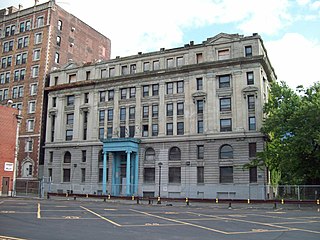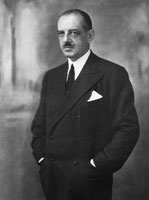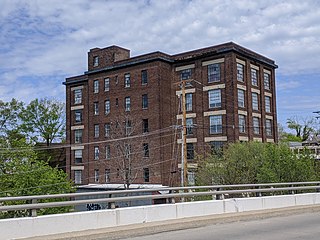
Albert Kahn was an American industrial architect. He was accredited as being an architect of Detroit and also designed industrial plant complexes such as the Ford River Rouge automobile complex. He designed the construction of Detroit skyscrapers and office buildings as well as mansions in the city suburbs. He led an organization of hundreds of architect associates and in 1937, designed 19% of all architect-designed industrial factories in the United States. Under a unique contract in 1929, Kahn established a design and training office in Moscow, sending twenty-five staff there to train Soviet architects and engineers, and to design hundreds of industrial buildings under their first five-year plan. They trained more than 4,000 architects and engineers using Kahn's concepts. In 1943, the Franklin Institute posthumously awarded Kahn the Frank P. Brown Medal.

The Buffalo Niagara Medical Campus (BNMC) is a medical center of health care, life sciences research and medical education institutions, co-located on 120 acres (49 ha) in Buffalo, New York. The BNMC was founded in 2001 by a consortium. This project comprises one of the five "Strategic Investment Areas" that make up Buffalo, NY's Queen City Hub Plan, the city's strategic plan for urban redevelopment.

The Guaranty Building, formerly called the Prudential Building, is an early skyscraper in Buffalo, New York. It was designed by Louis Sullivan and Dankmar Adler and completed in 1896. The building has been declared a National Historic Landmark and is located within the Joseph Ellicott Historic District.

Trico is an American company that specializes in windshield wipers. Trico, then known as Tri-Continental Corporation, invented the windshield wiper blade in 1917. Its original Trico Plant No. 1 is listed on the National Register of Historic Places. Trico is today one of the leading manufacturers of windshield wiping systems, windshield wiper blades and refills globally, with wiper plants on five continents.

James Addison Johnson was an American architect known for his design of various architectural landmarks in Buffalo, New York, and his use of decorative work that many consider a foreshadowing of art deco design.

Berkeley Apartments, also known as the Graystone Hotel, is a historic apartment hotel building located at Buffalo in Erie County, New York.

Pierce Arrow Factory Complex is a national historic district consisting of the former Pierce-Arrow automobile factory located at Buffalo in Erie County, New York.

M. Wile and Company Factory Building is a historic garment factory located at Buffalo in Erie County, New York. It is an early and significant example of the "Daylight Factory." The four-story building, erected in 1924, is constructed of reinforced concrete and features curtain walls of metal sash windows. It was home to M. Wile & Company until 1999; a major manufacturer of men's suits, founded by Mayer Wile in Buffalo in 1877. In 1969, the company became a subsidiary of Hartmarx.

The Packard Automotive Plant was an automobile-manufacturing factory in Detroit, Michigan, where luxury cars were made by the Packard Motor Car Company and later by the Studebaker-Packard Corporation. Demolition began on building 21 on October 27th, 2022, and a second round of demolition began on building 28 on January 24th, 2023, which was wrapped up by April 1st, however all demolition efforts by the City of Detroit halted, which stopped finishing demolition work of building 21. The Packard Plant currently sits empty and partially demolished, with many parcels still remaining.

The Architecture of Buffalo, New York, particularly the buildings constructed between the American Civil War and the Great Depression, is said to have created a new, distinctly American form of architecture and to have influenced design throughout the world.
Upstate New York has been the setting for inventions and businesses of international significance. The abundance of water power and the advent of canal and rail transportation provided nineteenth century Upstate New York entrepreneurs with the means to power factories and send their products to market. In the twentieth century, hydroelectric power and the New York State Thruway served the same roles. In April 2021, GlobalFoundries, a company specializing in the semiconductor industry, moved its headquarters from Silicon Valley, California to its most advanced semiconductor-chip manufacturing facility in Saratoga County, New York near a section of the Adirondack Northway, in Malta, New York.

The Larkin Terminal Warehouse also known as Larkin at Exchange or the Larkin R/S/T Building is located at 726 Exchange Street, Buffalo, New York in a neighborhood known as the "Hydraulics". The neighborhood was one of Buffalo's earliest industrial districts and it derived its name from the construction of a small hydraulic canal. The building, clearly visible from the I-190 interstate, was originally part of the Larkin Company and was one of the last constructed buildings in the complex. The building has a radio tower on the roof erected by WEBR-AM in 1936.

The Florida and Third Industrial Historic District is a group of multistory industrial lofts built from 1891 to 1928 near the Soo Line rail-yard in Milwaukee, Wisconsin, United States. It was added to the National Register of Historic Places in 2008.

Julius Kahn was an American engineer, industrialist, and manufacturer. He was the inventor of the Kahn system, a reinforced concrete engineering technique for building construction. The Kahn system, which he patented in 1903, was used worldwide for housing, factories, offices and industrial buildings. He formed his own company, Trussed Concrete Steel Company, as a manufacturing source for his inventions. He also founded United Steel Company and was chairman of Truscon Laboratories.

The Buffalo area economy consists of a mix of industrial, light manufacturing, high technology, and service-oriented private sector companies. Instead of relying on a single industry or sector for its economic future, the region has taken a diversified approach that has the potential to create opportunities for growth and expansion in the 21st century.
Ellicott Development Co. is an American property management, leasing and development real estate firm based in Buffalo, New York and led by CEO William Paladino. The company's asset base includes residential, commercial, hotels, parking garages, and convenience stores. Ellicott Development Co.’s services include legal, administrative, financial, management, accounting, development, site selection, site assemblage, architectural design and drafting services, construction, leasing, maintenance, janitorial and security services.

Herschell–Spillman Motor Company Complex, also known as the Remington Rand, Inc. Complex, is a historic daylight factory complex located at North Tonawanda, Niagara County, New York. The original section was built about 1895 as the powerhouse for the Buffalo and Niagara Falls Electric Railway. Later reinforced concrete and brick factory additions were made for the Herschell Spillman Company in about 1913, 1917, 1920, and 1920–1921. These include a four-story, section and additions made to earlier buildings to raise them to four stories and form an "L"-shaped complex. Also on the property is a five-story water tower. Herschell Spillman occupied the plant until it was sold to Remington Rand in 1925. Remington Rand continued operations at the factory until about 1965. The buildings have been renovated into loft apartments.

John R. Oishei was a businessman who founded Trico products and became one of Buffalo’s wealthiest citizens and philanthropists.

F.N. Burt Company Factory "C", also known as Bison Storage, is a historic box factory building in Buffalo, Erie County, New York. It was built in 1911. It was listed on the National Register of Historic Places in 2017.

The Jones Heel Manufacturing Company buildings are a set of historic industry buildings in the Brewery District neighborhood of Columbus, Ohio. The buildings, at the entrance to the Scioto Audubon Metro Park, housed the factory and warehouse of the Jones Heel Manufacturing Company, one of several shoe companies in the city in the 20th century, and one of the largest in the U.S. in 1919. The buildings are currently vacant.
























